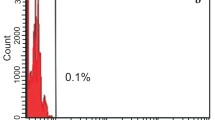Abstract
WHEN platelets in citrated plasma are exposed to latex (polystyrene) particles, the particles adhere to the platelets1 and are phagocytosed by them2. In association with this process, the platelets undergo clumping. Both the phagocytosis and the aggregation depend on the presence of divalent cations, as they are inhibited by the sodium salt of ethylenediaminetetraacetic acid (EDTA). It seemed important, then, to determine whether the initial adherence between particles and platelets was also dependent on the presence of divalent cations.
Similar content being viewed by others
References
Glynn, M. F., Movat, H. Z., Murphy, E. A., and Mustard, J. F., J. Lab. Clin. Med., 65, 179 (1965).
Movat, H. Z., Weiser, W. J., Glynn, M. F., and Mustard, J. F., Cell Biol. (in the press).
Roberts, J., and Quastel, J. H., Biochem. J., 89, 150 (1963).
Hovig, T., Thromb. et Diath. Hemorrh., 9, 264 (1963).
Hughes, J., and Lapiere, Ch. M., Thromb. et Diath. Hemorrh., 11, 327 (1964).
Author information
Authors and Affiliations
Rights and permissions
About this article
Cite this article
GLYNN, M., HERREN, R. & MUSTARD, J. Adherence of Latex Particles to Platelets. Nature 212, 79–80 (1966). https://doi.org/10.1038/212079a0
Issue Date:
DOI: https://doi.org/10.1038/212079a0
- Springer Nature Limited
This article is cited by
-
St�rungen von Thrombocytenfunktionen w�hrend der ikterischen Phase der akuten Virushepatitis
Zeitschrift f�r Kinderheilkunde (1974)





